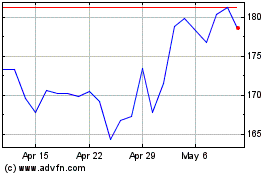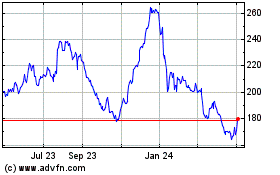By Aresu Eqbali in Tehran and Rory Jones in Dubai
Iran said a Ukrainian airliner that crashed outside of an
airport in Tehran, killing all 176 people on board, was shot down
unintentionally by its armed forces.
Iranian officials had initially denied claims by Western
officials that the Boeing Co. 737-800 jet was downed by a missile
system fired by Iran, possibly by mistake.
The single-aisle jet crashed Wednesday four hours after Iran had
launched military strikes against the U.S. in Iraq in retaliation
for the killing of a top general, and the Middle Eastern state was
on high alert for a potential U.S. response.
The Ukraine International Airlines plane approached a sensitive
military base operated by the Islamic Revolutionary Guard Corps and
was downed due to "human error," Iran's general staff of the armed
forces said in a statement on state television early Saturday local
time.
The armed forces detected greater U.S. air activity and U.S.
warplanes on its radar after the Iranian strikes on American forces
in Iraq, the statement said.
Iranian President Hassan Rouhani tweeted that the downing was a
"great tragedy & unforgivable mistake."
Iranian Foreign Minister Javad Zarif said the error was caused
by "U.S. adventurism" in the Middle East. "Our profound regrets,
apologies and condolences to our people, to the families of all
victims, and to other affected nations," he tweeted.
The airline and a spokeswoman for Ukrainian President Volodymyr
Zelensky didn't immediately respond to a request for comment.
Since the Iranian strikes, President Trump has said the U.S.
didn't plan to respond to Iran and that Iranian forces appeared to
be standing down from further conflict with American forces.
The downing of the jet, which killed a number of Iranians, is
likely to place further pressure on Iran's leadership, already
challenged by U.S. sanctions that have prompted an economic crisis
and widespread public protest.
Until Saturday, Iranian officials had repeatedly denied that the
jet was shot down by its armed forces, despite claims by U.S., U.K.
and Canadian officials that it crashed after being hit by
missiles.
Iranian investigators had said the plane likely crashed due to a
technical error and the pilot was attempting to return to Tehran's
main international airport when it hit the ground.
On Friday, Tehran gave Ukrainian investigators access to the
so-called black-box data and cockpit voice recorders, and Iranian
investigators said they would be willing to hand them over to other
countries as well for analysis.
Ukraine's foreign minister, Vadym Prystaiko, told reporters
Friday that so far Iran has granted full access for Ukraine to
conduct its investigation. A team of 45 Ukrainian experts and
officials is on the ground in Tehran, Ukrainian officials said.
Iranian officials also have invited investigators from Boeing,
the U.S., Ukraine, France and Canada to probe the causes of
Wednesday's crash, including a number of Canadians.
The National Transportation Safety Board, the U.S. entity tasked
with transport-accident investigations, said it is monitoring the
situation and evaluating its level of participation.
Boeing has started preparing the necessary paperwork and has
been in touch with both the State and Commerce departments, The
Wall Street Journal reported Thursday.
In the normal course of an investigation, some level of
participation would also be expected from the Federal Aviation
Administration and General Electric Co., which made the plane's
engines with a French joint-venture partner.
Canada -- which said late Friday it lost 57 citizens in the
crash, down from its earlier statement of 63 -- has vowed to work
with international partners to ensure it is thoroughly
investigated.
The Iranian investigation team has said it would first seek to
analyze the black boxes in Iran. They could also be examined in
Russia, Ukraine, France or Canada, four countries that had
expressed a readiness to help, Iranian investigators said.
U.S. industry and government officials say the Iranians have the
ability to conduct routine downloads of black-box recorders, but
are skeptical they have the technical expertise and experience to
extract data from damaged devices.
The crash comes after Iran has undergone a convulsive few
months. At least 59 people died this week in a stampede at a
funeral march for Maj. Gen. Qassem Soleimani, the military
commander killed by a U.S. strike.
In November, hundreds of demonstrators were killed by security
forces when they rose up across the country in protest against
government austerity measures, prompted partly by American
sanctions. The security response was the deadliest in decades.
The Ukrainian jet isn't the first time tensions between the U.S.
and Iran have led to an aviation tragedy. In 1988, the U.S. Navy's
Vincennes warship downed Iran Air Flight 655 with an air-defense
missile.
U.S. officials said they mistook the Airbus SE A300 airliner for
a warplane they feared would attack the ship. All 290 people,
mostly Iranian, on the plane died, prompting an outpouring of
national grief in Iran.
Georgi Kantchev in Kyiv contributed to this article.
Write to Rory Jones at rory.jones@wsj.com
(END) Dow Jones Newswires
January 11, 2020 00:47 ET (05:47 GMT)
Copyright (c) 2020 Dow Jones & Company, Inc.
Boeing (NYSE:BA)
Historical Stock Chart
From Mar 2024 to Apr 2024

Boeing (NYSE:BA)
Historical Stock Chart
From Apr 2023 to Apr 2024
